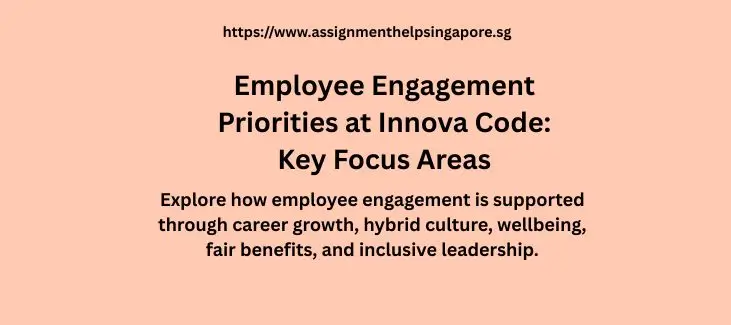
Contents
Employee Engagement Priorities at Innova Code: Key Focus Areas
Case Of Innova Code (This Is A Fictional Case)
It’s 8:30 a.m., and you’ve just logged into your home workspace when you notice a text message sent at 6:30 a.m. from your boss, Mr. David Lin, the Chief Operating Officer of Innova Code, a fast-scaling, 100-person software company that you recently joined as a talent strategist, learning and development lead, and employee engagement specialist.
Switching quickly into work mode, you read David’s urgent message. The company is facing a serious challenge in attracting and retaining talented young tech professionals, particularly Generation Z software engineers, designers, and product managers who will commit to Innova Code’s long-term mission and innovation roadmap.
“If we don’t address this talent issue immediately and prioritise how we’re using our HR budget, we’ll struggle to deliver on our product pipeline — especially our next-gen AI integration. This could delay our upcoming software release and jeopardise our Series B funding round. We need to be decisive about how we engage and grow our people.”
David knew from your hiring interviews that you had strong views about Gen Z workplace expectations and the shifting dynamics in tech. He’s asking you to prepare a proposal by the end of the week outlining how the HR budget should be allocated to maximise engagement and retention. Your recommendations will be part of a task force meeting where leaders from People & Culture, Engineering, and Product will consolidate their ideas into a final prioritisation list.
Innova Code is a 5-year-old tech startup that specialises in cloud-based productivity tools for digital-first businesses. Competing with other fast-growing firms across the Asia-Pacific, including Singapore, Vietnam, and Indonesia, the company prides itself on agility and innovation. However, its young, diverse team — mostly in their 20s and early 30s — is showing signs of disengagement. High turnover in the engineering and design teams has
raised concern.
David suspects that this generation, shaped by the digital age and post-pandemic work culture, values flexibility, purpose, and rapid development over traditional incentives. He’s aware of the so-called “Great Realignment” — a wave of rethinking priorities among younger workers — and doubts that offering higher pay or quirky benefits like “gadget stipends” will be enough.
Instead, David believes that true engagement, development, and belonging are what will drive performance and loyalty. Once the team decides which areas of the HR budget to focus on, Innova Code can invest in more strategic learning programs, career growth pathways, wellbeing support, or inclusive team practices to help people thrive.
In his message, David mentioned that a list of potential investment areas will be shared soon, and he wants your ranked priorities before the task force meets later in the week. You know you’ll need to reflect deeply, draw on research and trends in talent management, and be ready to advocate for the three areas you believe will have the greatest long-term impact.
Question 1 (Total 40 Marks):
General Research on How Each Area affects Employee Engagement Your boss has identified FIVE (5) key areas that are relevant to employee engagement, which is a key component of talent management. By applying theories and principles of talent management issues, analyse how each area contributes to employee engagement in
general. In other words, do research on how each of the FIVE (5) areas will affect employee engagement in general.
| Areas for Focus to Build Employee Engagement | Notes on how each area contributes to employee engagement (150 words maximum for each area). You can use footnotes or endnotes to cite your points. Your answer to each area is worth 8 marks. |
|---|---|
| Career development and internal mobility | |
| Building a cohesive hybrid culture and collaboration | |
| Mental Wellbeing | |
| Compensation and benefits | |
| Inclusive leadership |
Question 2 (Total 60 Marks):
Employee Engagement in Context of Innova Code Now, use the table below to rank in order the areas of focus (1 = most important, prioritised, 5 = least important, least prioritised). Do this in the context of Innova Code. In other words, consider the context, situation of Innova Code, and rank in order of importance, the areas of focus for employee engagement.
| Areas for Focus to Build Employee Engagement | Ranking |
|---|---|
| Career development and internal mobility | |
| Building a cohesive hybrid culture and collaboration | |
| Mental Wellbeing | |
| Compensation and benefits | |
| Inclusive leadership |
HRM Assignment Answers: Expert Answer for Above HRM Questions
| Areas for Focus to Build Employee Engagement | Notes on how each area contributes to employee engagement (150 words maximum for each area). You can use footnotes or endnotes to cite your points. Your answer to each area is worth 8 marks. |
|---|---|
| Career development and internal mobility | Employee engagement is highly affected by a large number of areas including career development and internal mobility, as it is evidence that employees that are clear with their career path contribute their maximum effort in achieving organisational goals through high engagement across teams. |
| Building a cohesive hybrid culture and collaboration | A cohesive hybrid culture and collaboration also promotes employee engagement, as such an environment reduces isolation, and makes employees feel as if they are included and aligned with the shared goals and thereby enhances engagement. |
| Mental Wellbeing | Mental wellbeing initiatives in the organisation such as counselling, flexible schedules and workload management makes employees feel supported and valued and thereby drives higher energy, creativity and loyalty towards the organisation. |
| Compensation and benefits | Fair compensation and benefits also drives engagement among employees. The compensation policies should be such that it encourages equity and transparency so that it can help in building trust among employees and encourage them to remain committed towards the organisation. |
| Inclusive leadership | Inclusive leadership helps in building trust and makes employees feel psychologically safe and drives them towards higher engagement. |
| Disclaimer: This answer is a model for study and reference purposes only. Please do not submit it as your own work. |
Want a Full Worked Out Answer with References?
Check Samples on HRM Assignment Written by Experts
Related answers
Workplace Diversity & Allyship in Singapore – HRM358
AI vs Human Judgment in Cross-Cultural HRM
AI in Talent Acquisition: Applications, Risks & Strategy
Singapore Work Permit Revamp: Longer Tenure, New Sources
Talent Management Dilemmas: HR Decision-Making with AI
Strategic IHRM Case Study Report: Global HR Challenges
Reflective Skills Analysis and Future Success Action Plan for MBA
Human Resource Management Strategy Assignment Answers



